
| Author(s) | Beauchamp, 2020 |
| Methodology | Defined from geological survey and geophysical data |
| Geological(s) subdivision(s) | Superior Province/Opinaca Subprovince |
| Main movement | Does not apply |
| Deformation style | Domes and basins |
| Metamorphic facies (mean facies related to main deformation) | Granulites |
Background and Methodology
The Ayr Structural Domain was defined by Beauchamp (2020) following a mapping survey conducted in the Cadieux Lake area in the summer of 2018, and by analyzing high-resolution aeromagnetic survey maps (D’Amours, 2011). Chartier-Montreuil et al. (2024) redefined the domain boundaries using geophysical data processed by Cleven et al. (2020) and mapping work by Massei and Hammouche (2016) in the Emmanuel Lake area.
The Ayr Structural Domain takes its name from the eponymous lake located on the contiguous boundary of NTS sheets 33A07 and 33A10.
Boundaries and Morphology
| Width (km) | 25 to 45 |
| Length (km) | 75 |
| Orientation | NW-SE elongation |
The morphology of the Ayr Structural Domain (DSayr) corresponds to a NW-SE ellipse associated with a major regional fold axis. To the SE, the DSayr is in contact with the Cadieux Structural Domain. To the north and NE, it shares its boundary with the Kaawaischiskau Structural Domain. The rocks to the west and southwest of the domain are occupied by paragneiss and granite from the Opinaca Subprovince, which do not belong to any formally defined structural domain.
Stratigraphic Units Concerned
The lithostratigraphic and lithodemic units that make up the Ayr Structural Domain are:
- variably migmatized metasedimentary rocks (units nAlgi2a, nAlgi3a and nAlgi4b) of the Laguiche Complex;
- the Nikos Suite (units nAnik1 and nAnik2).
Note that most of the Opinaca Subprovince rocks belonging to this structural domain have not yet been assigned to a formal unit. They include a variety of lithologies: paragneiss, granite, granodiorite, quartz syenite, monzonite, quartz monzodiorite, diorite, and amphibolite.
Structural Characteristics
❯ Main Fabrics
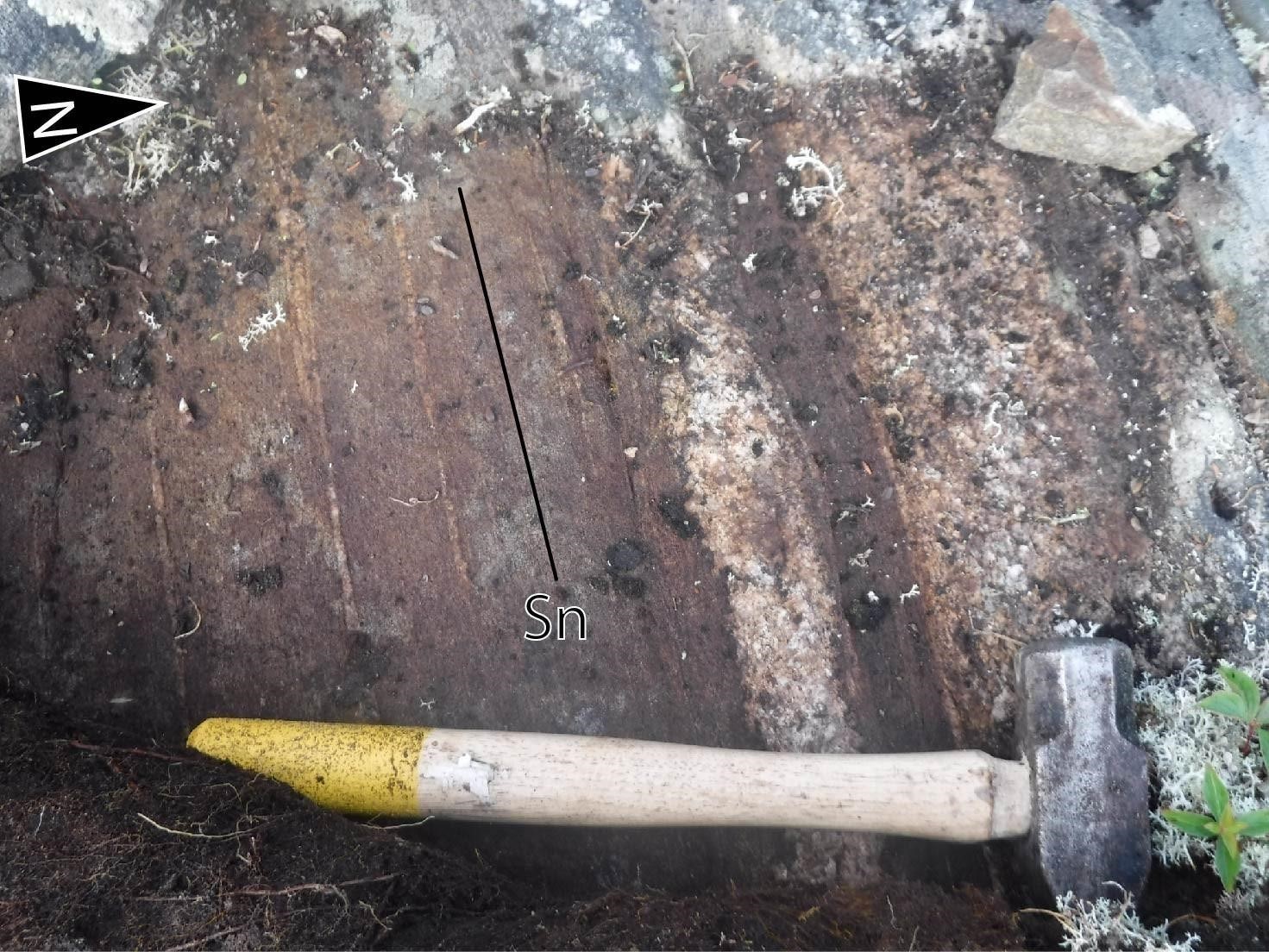
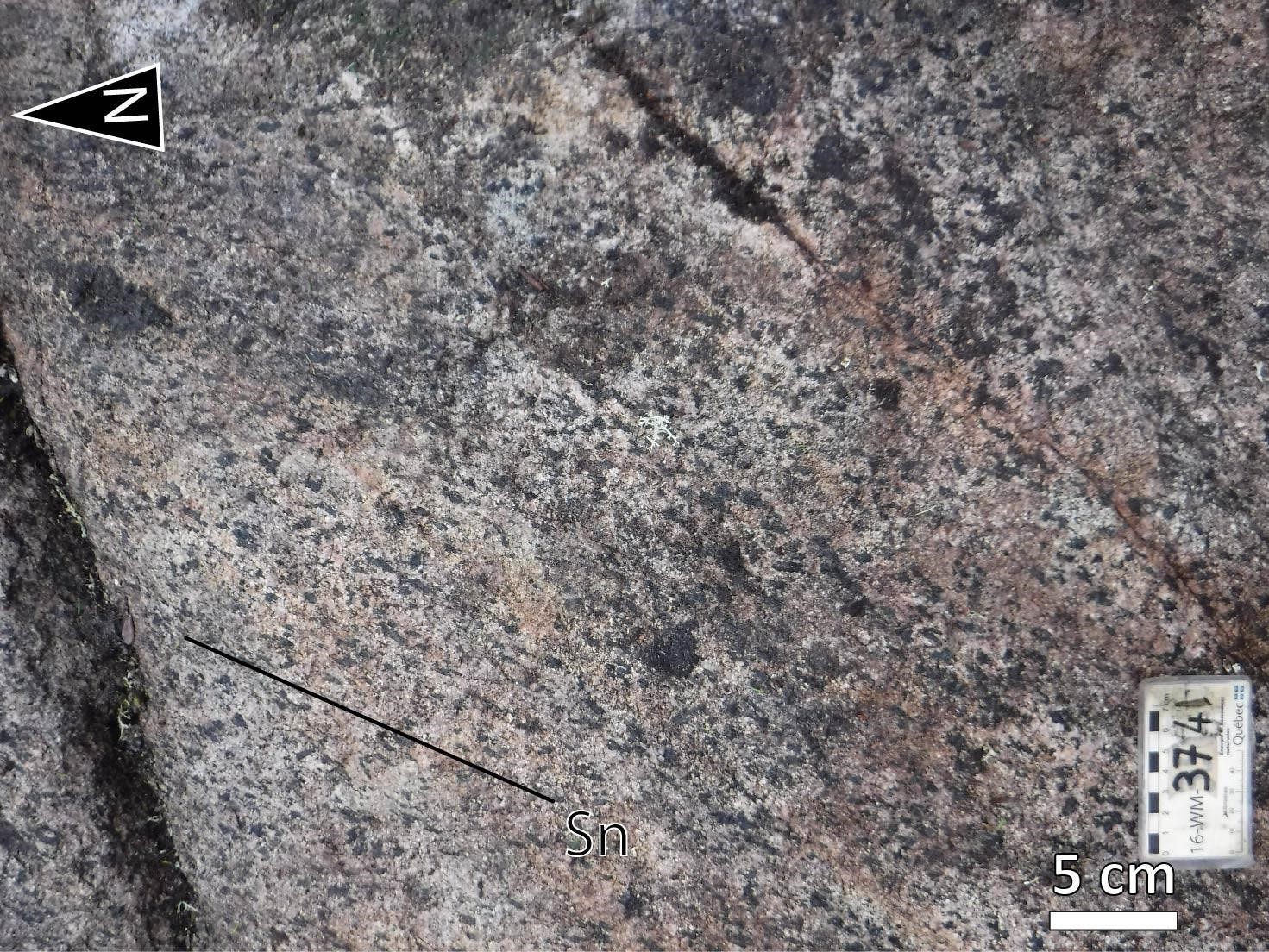 The main fabrics recognized within the DSayr are the Sn tectonometamorphic foliation and the Mn migmatitic banding. The preferential orientation of euhedral to subhedral biotite flakes emphasizes the Sn foliation in granoblastic paragneiss. Where migmatitic banding is stromatic, mobilisate bands are subparallel to the main Sn foliation. In some diatexites, rafts have an orientation that is consistent with the trace of a regional foliation. At the domain scale, the regional Sn foliation is folded. Foliation poles all line up in a great circle which is oriented NNE, suggesting that it is folded.
The main fabrics recognized within the DSayr are the Sn tectonometamorphic foliation and the Mn migmatitic banding. The preferential orientation of euhedral to subhedral biotite flakes emphasizes the Sn foliation in granoblastic paragneiss. Where migmatitic banding is stromatic, mobilisate bands are subparallel to the main Sn foliation. In some diatexites, rafts have an orientation that is consistent with the trace of a regional foliation. At the domain scale, the regional Sn foliation is folded. Foliation poles all line up in a great circle which is oriented NNE, suggesting that it is folded.
| Main Fabric | Type of Fabric | Direction (°) | Dip (°) | Number of Measurements | Comments |
| Sn foliation | Tectonometamorphic foliation and migmatitic banding | 328 | 21 | 121 | Foliation poles and migmatitic banding are all aligned in a great circle which is oriented 154°/71°, indicating that this foliation is folded. |
| Ln lineation | Stretch lineation and mineral lineation | – | – | 8 |
Very scarce and non-representative number of measurements |
❯ Other Fabrics
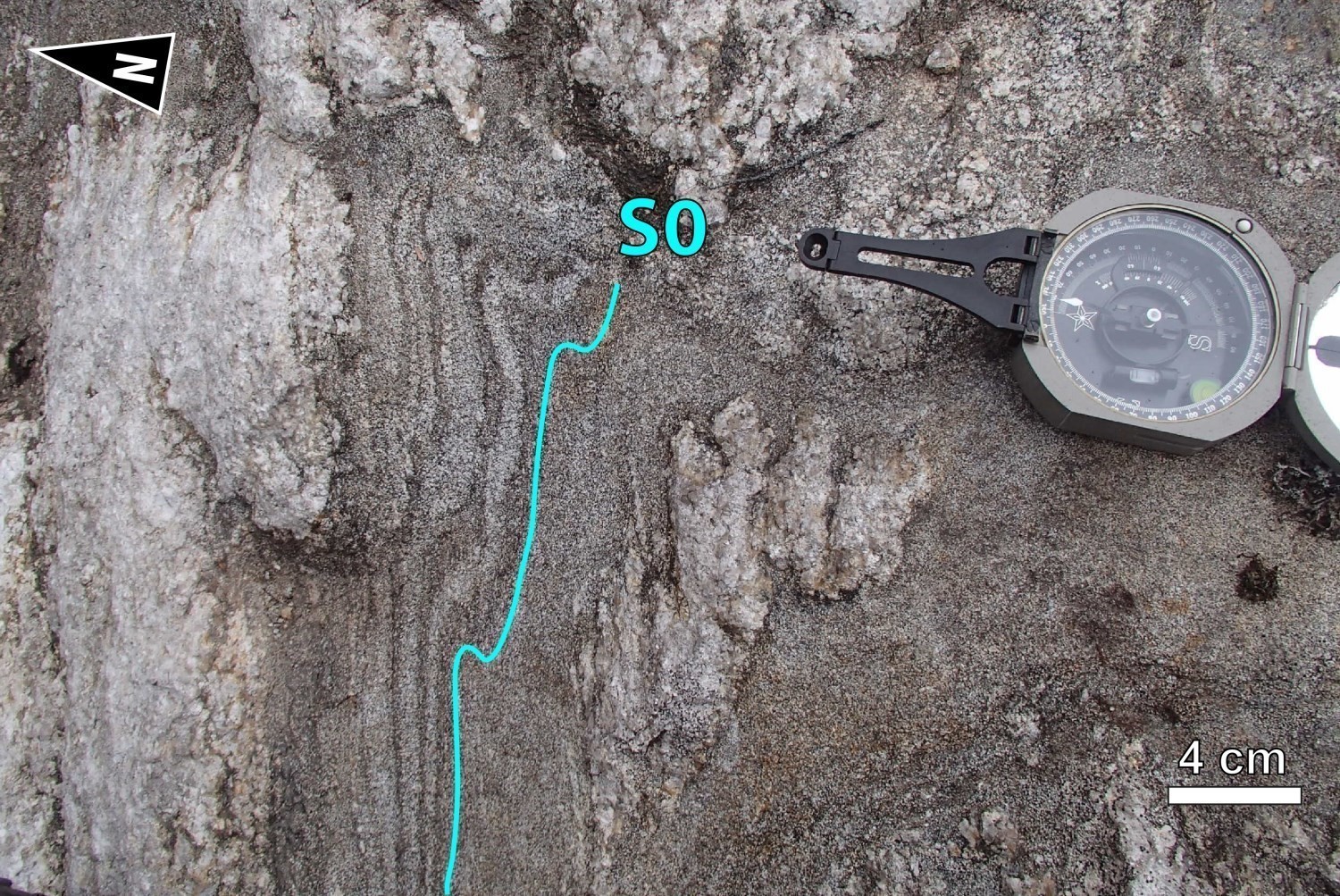 The S0 stratification, which corresponds to compositional banding, is observed on some sedimentary rock outcrops of the Laguiche Complex (outcrops 18-FM-2092 and 18-LP-6143). Compositional banding is characterized by alternating beds that are richer in biotite, and which were originally more argillaceous, and beds that are poorer in biotite, which represent sandstone beds. It is commonly folded and generally shows a NNW-SSE orientation. Locally, the difference in the apparent partial melting rate within the same outcrop can be explained, among other things, by the presence of compositional banding. Some layers are completely melted (diatexite and anatectic granite), while others only experienced partial melting (paragneiss and metatexite).
The S0 stratification, which corresponds to compositional banding, is observed on some sedimentary rock outcrops of the Laguiche Complex (outcrops 18-FM-2092 and 18-LP-6143). Compositional banding is characterized by alternating beds that are richer in biotite, and which were originally more argillaceous, and beds that are poorer in biotite, which represent sandstone beds. It is commonly folded and generally shows a NNW-SSE orientation. Locally, the difference in the apparent partial melting rate within the same outcrop can be explained, among other things, by the presence of compositional banding. Some layers are completely melted (diatexite and anatectic granite), while others only experienced partial melting (paragneiss and metatexite).
❯ Folds
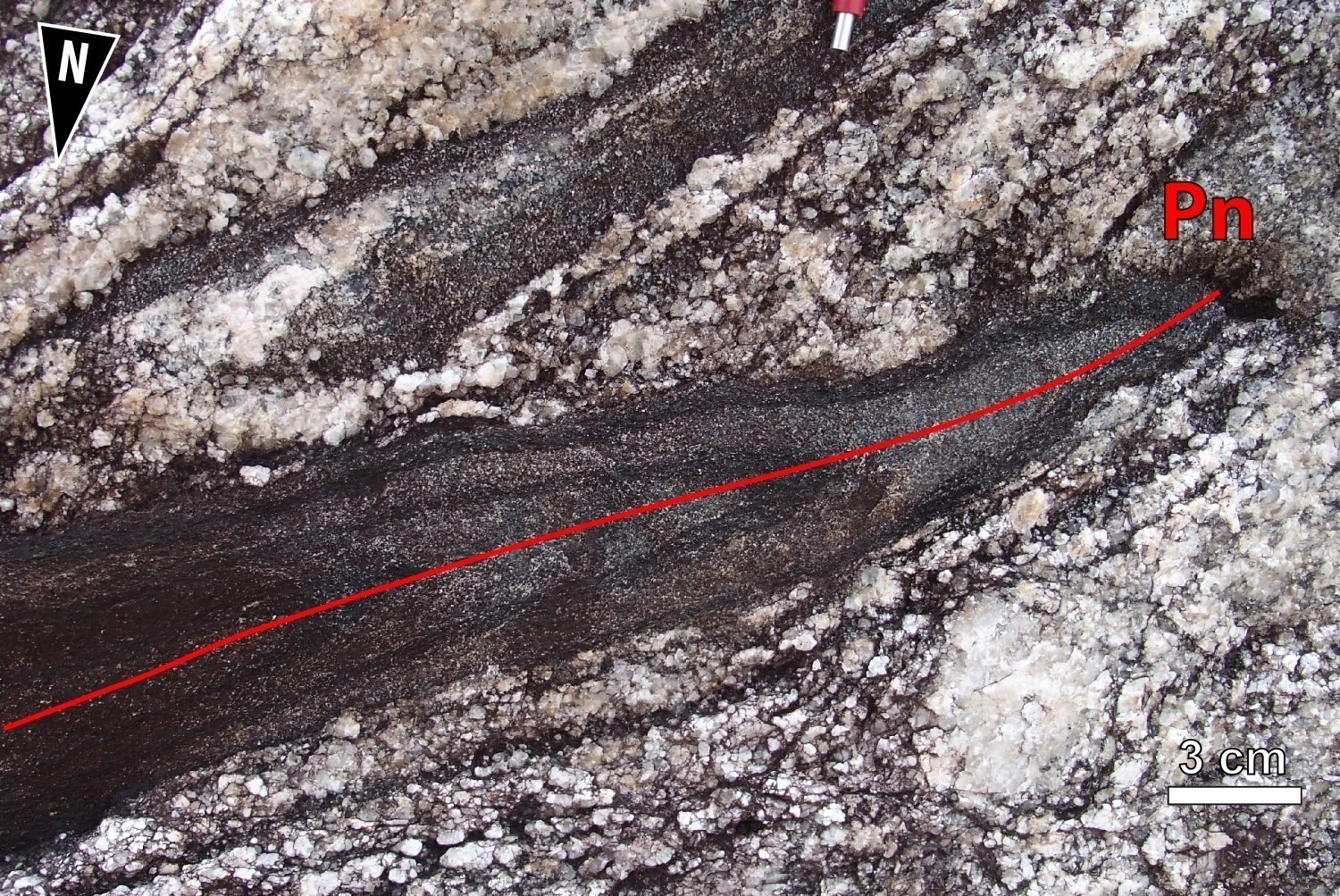
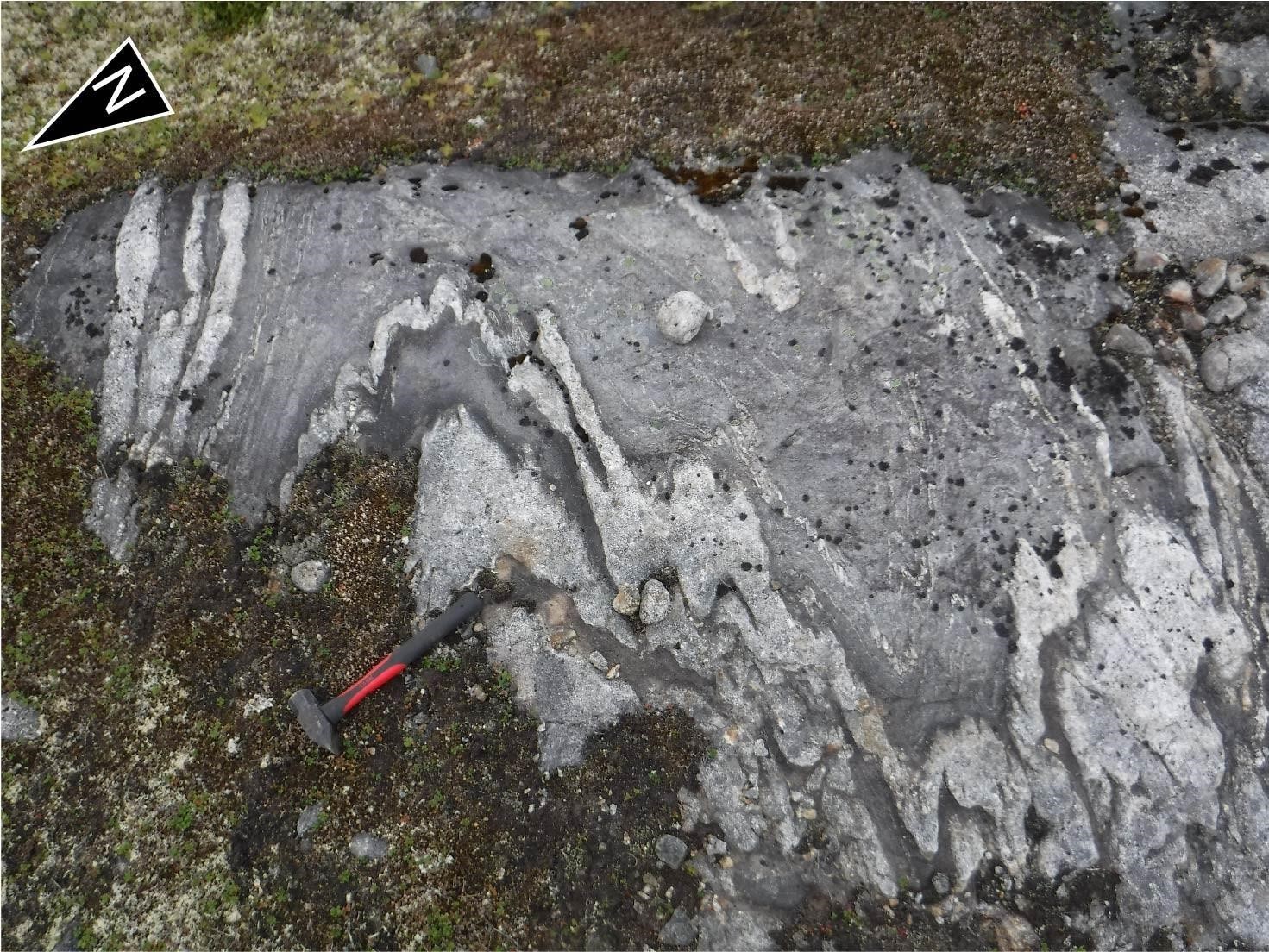 Folding in the Ayr Structural Domain is very chaotic in style and attitude, which makes it difficult to interpret (migmatitization texture and ptygmatitic folding). Some remains of tight to isoclinal Pn tectonic folds with ENE-WSW axial planes are preserved in the least melted parts of the Laguiche Complex metasedimentary sequence (outcrops 18-MP-5048, 18-LP-6014 and 18-LP-6144). The earliest mobilisate phases in the tectonometamorphic history are affected by Pn folding. The axial plane fabric is commonly obliterated by extensive metamorphic recrystallization. Some Z-shaped drag folds suggest apparent dextral movements.
Folding in the Ayr Structural Domain is very chaotic in style and attitude, which makes it difficult to interpret (migmatitization texture and ptygmatitic folding). Some remains of tight to isoclinal Pn tectonic folds with ENE-WSW axial planes are preserved in the least melted parts of the Laguiche Complex metasedimentary sequence (outcrops 18-MP-5048, 18-LP-6014 and 18-LP-6144). The earliest mobilisate phases in the tectonometamorphic history are affected by Pn folding. The axial plane fabric is commonly obliterated by extensive metamorphic recrystallization. Some Z-shaped drag folds suggest apparent dextral movements.
Geometric Parameters of Regional Folds:
| Fold or Family of Folds | Type (Anticline, Syncline or Undetermined) | Shape (Antiform or Synform) | Attitude (Overturned or Upright) | Axial Plane | Fold Axis | Position (Certain or Probable) | Deformation Phase | Comments | ||
| Direction | Dip | Direction | Plunge | |||||||
| Pn fold | Anticline and syncline | Antiform and synform | Mainly overturned and upright | ENE-WSW | Variable | ENE | – | Certain and probable | Dn | Slightly plunging folds |
❯ Crosscutting Relationships
The DSayr is cut by steeply dipping, late NNW-SSE oriented brittle faults. Most of these faults have been inferred from maps of the residual magnetic field, vertical gradient and derivative tilt. At the outcrop scale, the expression of these late structures consists of brittle fractures that are either epidotized, hematitized or both.
❯ Kinematics
Does not apply.
Deformation Style
The Ayr Structural Domain displays a geometry of domes and basins. The morphology of the domain as a whole and its internal architecture demonstrate significant crustal deformation under sub-solidus conditions associated with strong N-S shortening.
Metamorphic Characteristics
Metasedimentary rocks of the Laguiche Complex are commonly highly migmatitized, with mobilisate commonly exceeding 50% of the total volume of the rock. The presence of paragneiss and metatexites in the southern part of the DSayr, evolving towards diatexites and anatectic granites in the northern part, indicates an increase in partial melting and possibly in the temperature gradient. Biotite is ubiquitous in this paragneiss. Garnet and hornblende are present locally, both in mobilisate found in restitic parts as well as in paleosome. A biotite-garnet mineralogical assemblage indicates that paragneiss reached metamorphic conditions typical of the upper amphibolite facies. Orthopyroxene was not observed in the Ayr Domain rocks. However, these are surrounded by rocks that have reached the granulites facies. Given the high proportion of partial melting, it is highly likely that the rocks in the Ayr Domain also reached the same granulites facies conditions.
At least three types of mobilisate are clearly visible in paragneiss, and are thought to have been emplaced during the great continuum of Dn deformation:
1) Thin (mm to cm) in situ leucosomes are subconformable to the S0 fabric, where present. These leucosomes are boudinaged, discontinuous and commonly folded by Pn folds. This mobilisate seems to have been emplaced during deformation Dn.
2) Large injections in the form of bands of granitic to tonalitic melting material, which are preferentially injected into Sn foliation planes. This generation of mobilisate gives a stromatic texture to the rock. This mobilisate would be synkinematic and its emplacement would correspond to the peak of Dn deformation.
3) The mobilisate that was emplaced late during Dn deformation cuts off the generations mentioned above.
Alterations
Does not apply.
Geophysical Characteristics
Aeromagnetic maps (D’Amours, 2011; Cleven et al., 2020) indicate that the Ayr Structural Domain has a very homogeneous magnetic pattern with a medium to high contrast. The domain boundaries correspond to the limits of the large NW fold axis characterizing the area, which can easily be identified due to the concordant orientation of the majority of magnetic lineaments. Relatively continuous bands characterize this boundary.
Chronological Markers
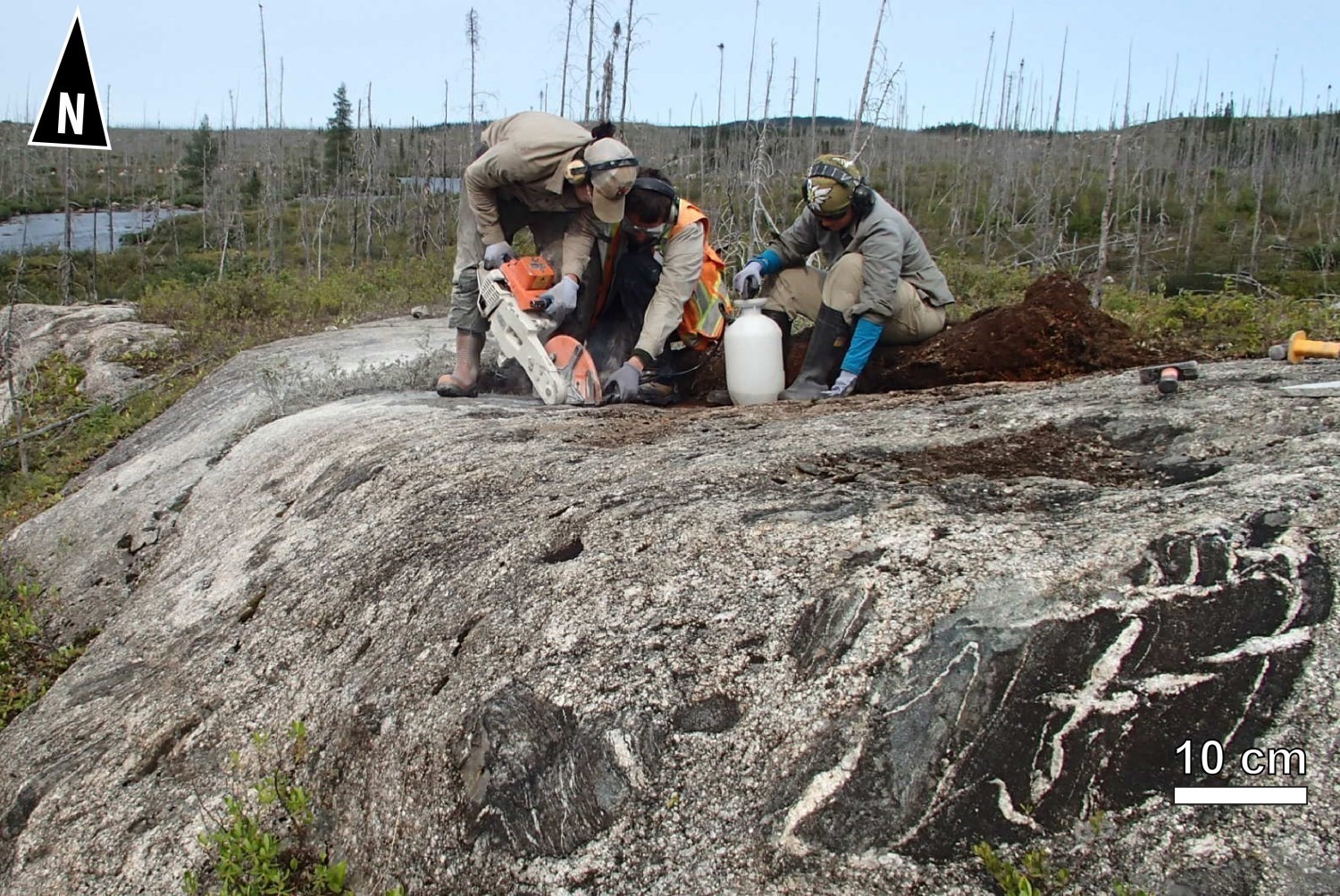 In the Ayr Structural Domain, a datation was performed on a sample of wacke-derived paragneiss from the Laguiche Complex (16-HH-1654-A, sheet 33A10). The monazite in this sample yielded a uniform age of 2692 ±6 Ma (Davis and Sutcliffe, 2018), which represents a metamorphic age and a minimum age of deposition for sedimentary rocks. This age seems to correspond to the metamorphic episode associated with partial melting of sedimentary rocks in the complex; it could therefore date the Dn deformation phase. Two anatectic granite samples also collected in the Laguiche Complex (16-AS-6666-A, sheet 33A10 and 18-SG-7102-A, sheet 33A07 in the Kaawaischiskau Structural Domain) provided crystallization ages (U-Pb on zircons) of 2674 ±5 Ma (Davis and Sutcliffe, 2018) and 2684 ±3 Ma (Davis, 2019), respectively.
In the Ayr Structural Domain, a datation was performed on a sample of wacke-derived paragneiss from the Laguiche Complex (16-HH-1654-A, sheet 33A10). The monazite in this sample yielded a uniform age of 2692 ±6 Ma (Davis and Sutcliffe, 2018), which represents a metamorphic age and a minimum age of deposition for sedimentary rocks. This age seems to correspond to the metamorphic episode associated with partial melting of sedimentary rocks in the complex; it could therefore date the Dn deformation phase. Two anatectic granite samples also collected in the Laguiche Complex (16-AS-6666-A, sheet 33A10 and 18-SG-7102-A, sheet 33A07 in the Kaawaischiskau Structural Domain) provided crystallization ages (U-Pb on zircons) of 2674 ±5 Ma (Davis and Sutcliffe, 2018) and 2684 ±3 Ma (Davis, 2019), respectively.
References
Publications Available Through Sigéom Examine
BEAUCHAMP, A.-M., 2020. Géologie de la région du lac Cadieux, sous-provinces d’Opatica et d’Opinaca, Eeyou Istchee Baie-James, Québec, Canada. MERN; BG 2018-02, 2 plans.
CHARTIER-MONTREUIL, W., TALLA TAKAM, F., BEAUCHAMP, A.-M., MASSEI, F., 2024. Géologie de la région du lac Léran, sous-provinces d’Opatica, d’Opinaca et de la Grande, Eeyou Istchee Baie-James, Québec, Canada. MRNF; BG 2016-01.
CLEVEN, N.R., HARRIS, L.B., GUILMETTE, C., 2020. Structural interpretation of enhanced high-resolution aeromagnetic depth slices of the Eeyou Istchee Baie-James region, Québec Superior province. UNIVERSITÉ LAVAL, INRS, MERN; MB 2020-02, 84 pages.
D’AMOURS, I., 2011. Synthèse des levés magnétiques de la Baie-James. MRNF; DP 2011-08, 5 pages, 2 plans.
DAVIS, D.W., SUTCLIFFE, C.N., 2018. U-Pb Geochronology of Zircon and Monazite by LA-ICPMS in samples from northern Quebec. UNIVERSITY OF TORONTO; MB 2018-18, 54 pages.
DAVIS, D.W., 2019. Rapport sur les datations U-Pb de roches du Québec 2018-2019, projets Lac Cadieux et Lac Watts. UNIVERSITY OF TORONTO; MB 2019-09, 82 pages.
HOCQ, M., 1985. Géologie de la région des lacs Campan et Cadieux, Territoire-du-Nouveau-Québec. MRN; ET 83-05, 190 pages and 4 plans.
MASSEI, F., HAMMOUCHE, H., 2016. Géologie – Région du lac Emmanuel. MERN; CG-2016-09, 1 plan.
Suggested Citation
Contributors
|
First publication |
Anne-Marie Beauchamp, P. Geo., M.Sc. anne-marie.beauchamp@mern.gouv.qc.ca (redaction) Ghyslain Roy, P. Geo. (coordination); Patrice Roy, P. Geo., Ph.D. (critical review); Simon Auclair, P. Geo., M.Sc. (editing); Ricardo Escobar (HTML editing); Céline Dupuis, P. Geo., Ph.D. (English version) |
|
Revision(s) |
William Chartier-Montreuil, P. Geo., william.chartier-montreuil@mrnf.gouv.qc.ca (redaction) Hanafi Hammouche, P. Geo., M.Sc. (coordination); Daniel Bandyayera, P. Geo., Ph.D. (critical review); Simon Auclair, P. Geo., M.Sc. (editing); André Tremblay (HTML editing); Catherine Tremblay (English version) |

